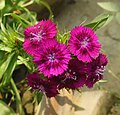Studenter-nellike
| Studenter-Nellike | |
|---|---|
 Studenter-Nellike (Dianthus barbatus) Foto: Andrey Korzun | |
| Videnskabelig klassifikation | |
| Rige | Plantae (Planter) |
| Division | Magnoliophyta (Dækfrøede planter) |
| Klasse | Magnoliopsida (Tokimbladede) |
| Orden | Caryophyllales (Nellike-ordenen) |
| Familie | Caryophyllaceae (Nellike-familien) |
| Slægt | Dianthus (Nellike) |
| Art | D. barbatus |
| Videnskabeligt artsnavn | |
| Dianthus barbatus L. | |
| Hjælp til læsning af taksobokse | |
Studenter-Nellike (Dianthus barbatus)[1] er en art af nellikeslægten, som er hjemmehørende i det sydlige Europa fra Pyrenæerne øst til Karpaterne og Balkan, med en række udspredninger i det nordøstlige Kina, Korea og sydøstlige Rusland.[2][3][4]
Beskrivelse
Studenter-nelliken er, som andre nelliker, en staude og vokser til en højde af 30-75 cm. Blomsterne sidder i en tæt klynge af op til 30 på toppen af stilkene, med grønne til blågrønne tilspidsede blade, som er 4-10 cm lange og 1-2 cm brede. Hver blomst er 2-3 cm i diameter med fem savtakkede kronblade.[4] Vilde studenter-nelliker producerer røde blomster med en hvid midte, men sorter og hybrider i andre farver spænder fra hvid, pink, rød og lilla, til brogede mønstre.[5]
Studenter-nelliker tiltrækker bier, fugle og sommerfugle.[6] De trives i leret, let basisk jord med sol til delvis skygge. Formering er ved frø eller afklippede stiklinger.
Planten blev introduceret til det nordlige Europa i det 16. århundrede, og senere til Nordamerika og andre steder, og er blevet naturaliseret i disse områder.[6][7]
Der er to varianter:[4]
- Dianthus barbatus var. barbatus. Sydeuropa. Bredere blade, op til 2 cm bred.
- Dianthus barbatus var. asiaticus. Nordøstlige Asien. Tyndere blade, ikke over 1 cm bred.
Galleri
Referencer
- ^ Thompson and Morgan plant catalog spelling - Sweet William
- ^ Flora Europaea: Dianthus barbatus
- ^ Med-Checklist: Dianthus barbatus
- ^ a b c Flora of China: Dianthus barbatus var. asiaticus
- ^ Huxley, A., ed. (1992). New RHS Dictionary of Gardening. Macmillan ISBN 0-333-47494-5.
- ^ a b Blamey, M. & Grey-Wilson, C. (1989). Flora of Britain and Northern Europe. ISBN 0-340-40170-2
- ^ Missouriplants: Dianthus barbatus Arkiveret 17. december 2013 hos Wayback Machine
| Søsterprojekter med yderligere information: |
Medier brugt på denne side
Forfatter/Opretter: HitroMilanese, Licens: CC BY-SA 4.0
Sweet William is a herbaceous biennial or short-lived perennial plant native to the mountains of southern Europe from the Pyrenees east to the Carpathians and the Balkans, with a variety disjunct in northeastern China, Korea, and southeasternmost Russia
Forfatter/Opretter: Tocekas, Licens: CC BY-SA 3.0
Dianthus barbatus. Veseluvka, Jonava district, Lithuania.
Forfatter/Opretter: Louise Docker from Sydney, Australia, Licens: CC BY 2.0
Photo of some pink Sweet William flowers (Dianthus barbatus).
Forfatter/Opretter: HitroMilanese, Licens: CC BY-SA 4.0
Sweet William is a herbaceous biennial or short-lived perennial plant native to the mountains of southern Europe from the Pyrenees east to the Carpathians and the Balkans, with a variety disjunct in northeastern China, Korea, and southeasternmost Russia
Forfatter/Opretter: HitroMilanese, Licens: CC BY-SA 4.0
Sweet William is a herbaceous biennial or short-lived perennial plant native to the mountains of southern Europe from the Pyrenees east to the Carpathians and the Balkans, with a variety disjunct in northeastern China, Korea, and southeasternmost Russia
Forfatter/Opretter: Kor!An (Андрей Корзун), Licens: CC BY-SA 3.0
Sweet William (Dianthus barbatus). Flower beds in the Moscow Botanical Garden of Academy of Sciences.
Forfatter/Opretter: Photo by and (c)2008 Derek Ramsey (Ram-Man). Co-attribution must be given to the Chanticleer Garden., Licens: CC BY-SA 3.0
Closeup picture of a flower cluster of the Sweet Williamen (Dianthus barbatus en 'Heart Attack'). Photo taken in the Tennis Court Garden at the Chanticleer Garden where the species was identified.
| |||
Sweet William.
















